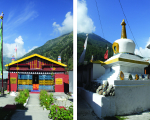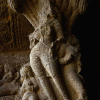The village of Bagori is a settlement of a transhumance community called the Bhotias, who were originally residents of the Nelang and Jadong valley of Uttarakhand. The main occupation of the community was animal husbandry and trading in the Tibetan and Indian markets. After the Indo-China War of 1962, they were relocated to Bagori and Dunda villages in the Uttarkashi district of Uttarakhand, India. With restrictions on trading, they adapted to agriculture as one of their occupations.
Unlike the terraced or staggered settlements found in the hilly regions, this village has a linear settlement with houses on either side of the street, with no boundary walls. The street acts as a social space for the community. With changing times, the community members have constructed boundary walls for privacy and security. Despite the new physical boundary, the community members use the street as a space to interact while knitting wool in their leisure time. The arrangement of houses and the house form is a result of their occupation of animal husbandry and climatic conditions. The houses are typically load-bearing structures built on stilts with columns that are made of either stone or a combination of stone and wood. Walls of the houses are built with the koti banal (timber-reinforced stone masonry) construction technique. The transhumance nature of the community led to the confluence of Hindu and Buddhist religious practices and beliefs. These influences have shaped the built environment of the Bagori village.
This image gallery demonstrates that the settlement pattern, house form, and its decorations are a result of the occupation of the community and their sociocultural influences, along with the climatic and geographic limitations.












